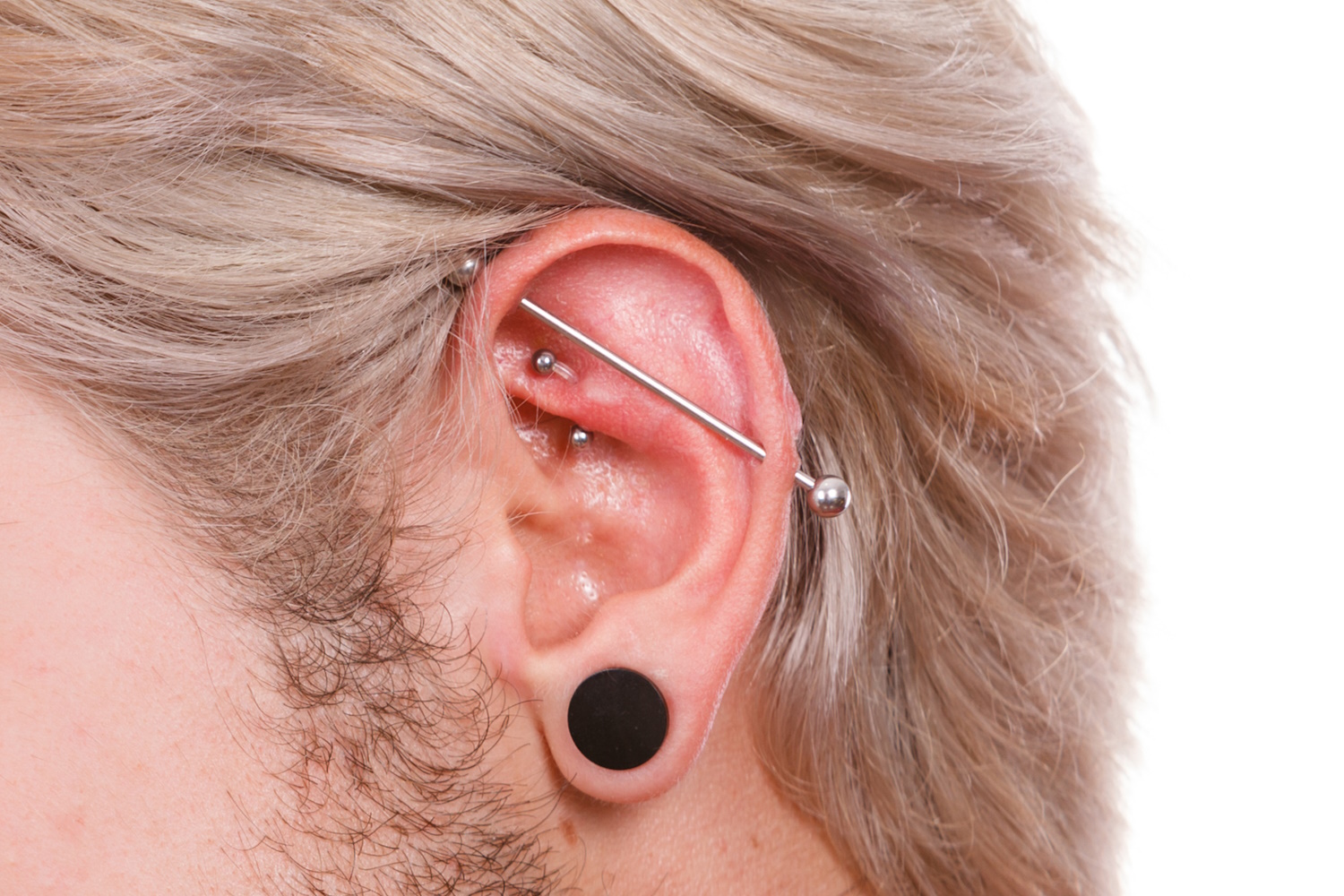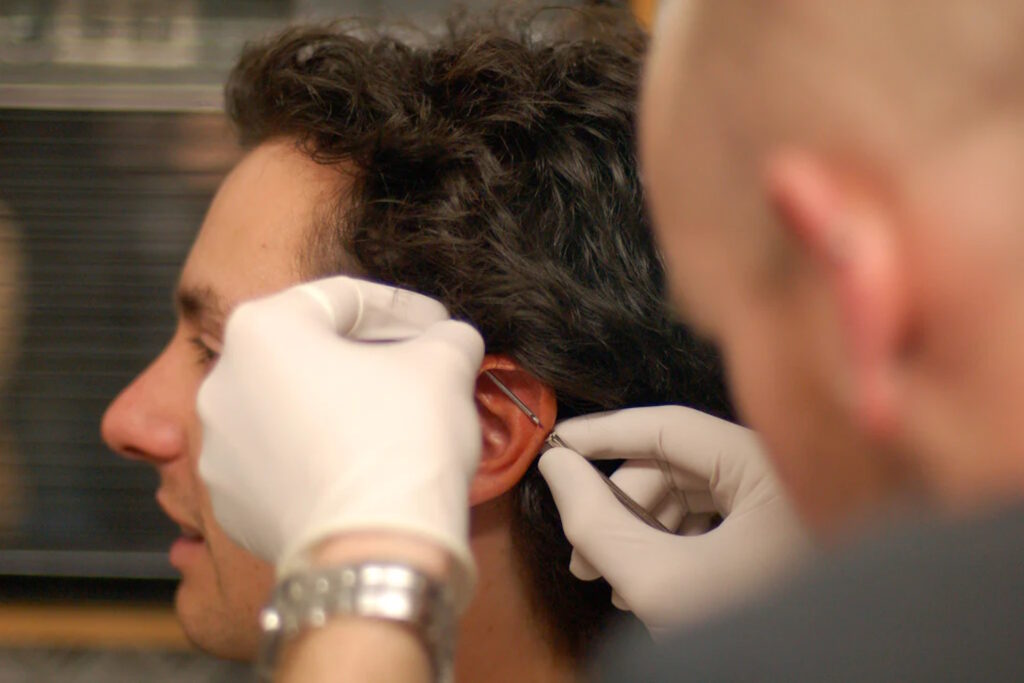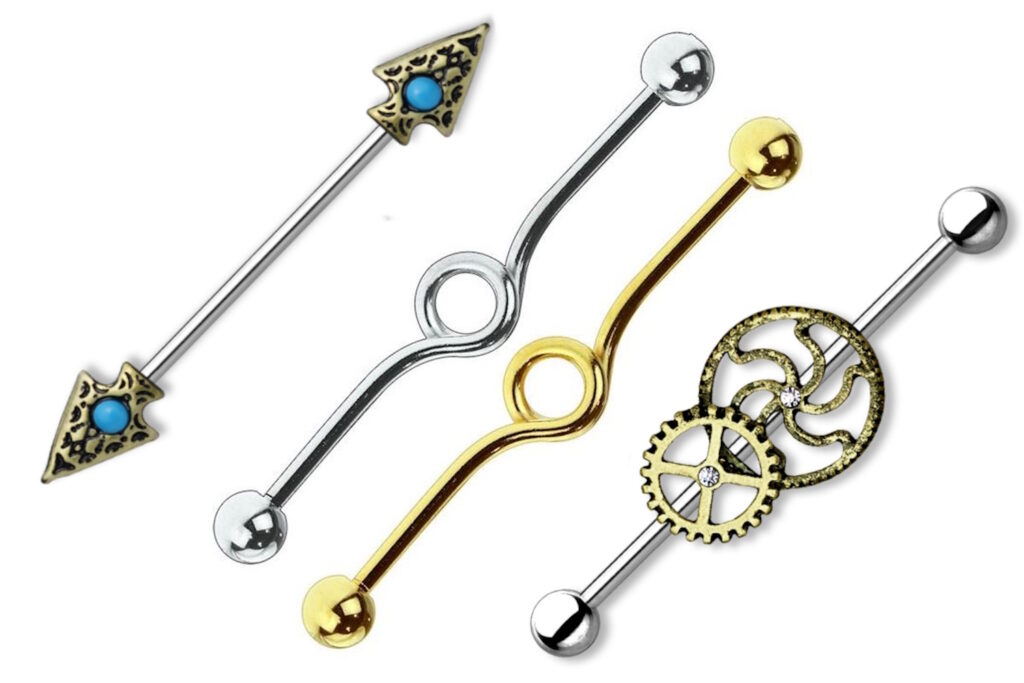
Industrial Piercing Essentials: A Rigorous Review
Industrial Ear Piercing Article Quick Reference:
History | Myths | Complications | Pain | Cost | Procedure | Healing | Aftercare | Jewelry | Celebrities
The industrial ear piercing AKA as a scaffold piercing or construction piercing. It is a popular type of ear piercing that involves piercing two holes through the upper ear cartilage. The holes are generally in a diagonal or horizontal line. A straight piece of jewelry, typically a long barbell, connects the two holes by passing through both.
The industrial piercing can be done in different parts of the upper ear. The exact location and angle depend on the individual’s anatomy and preferences. Some people choose to have the industrial piercing run straight across the ear, while others prefer a more angled placement. See the diagram below to get a more exact idea of where this popular piercing is located.

THE SHORT HISTORY OF INDUSTRIALS
The industrial ear piercing only became popular in the 1990s, thanks to the rising interest in punk and goth subcultures. So if you’re an industrial piercing enthusiast, you owe a debt of gratitude to that guy with the mohawk who hangs out in front of the record store.
But wait, there’s more! Some people speculate that the industrial piercing actually has roots in indigenous cultures, where ear piercings held symbolic significance. Of course, there’s no way to know for sure because ancient tribes didn’t have Instagram to document their body modifications. But honestly, who cares about the boring history when we can just focus on how cool it looks?
So whether you’re piercing your ears for cultural reasons or just because you want to look like a badass, know that the industrial piercing has come a long way. Who knows? Maybe one day it will be viewed as a classic style, like leather jackets and aviator sunglasses.
INDUSTRIAL MYTHS & MISCONCEPTIONS
There are a few common myths and misconceptions about industrial piercings. Here are a few to keep in mind:
- The Industrial Will Cause Your Ear Cartilage To Shatter: This is a common myth that often scares people away from getting an industrial piercing. However, a reputable piercer will use sterilized, high-quality equipment to minimize the risk of any cartilage damage.
- The Industrial Piercing Will Cause Unbearable Pain: The industrial piercing may be more painful than a typical ear piercing. Actually, though, it is still bearable for most people. Pain tolerance is subjective and varies among individuals. Many people find that the process feels like a sting or pressure more than anything else.
- It Will Affect Your Hearing Or Balance: This is a false myth. The industrial piercing is located in the upper ear cartilage. It has no connection to the ear’s inner workings that affect hearing or balance.
- The Piercing Will Leave A Noticeable Scar: All piercings, including the industrial piercing, will leave a small scar once removed. However, the scar is typically small and hardly noticeable, especially with proper aftercare and maintenance.
These myths may discourage you from wanting an industrial ear piercing. But keep in mind they are just that, myths. It is vital to understand the facts about industrial piercings. This includes the proper aftercare and the healing process. Also, know the materials used in the jewelry, and the equipment required for the piercing. This helps make an informed decision.
FROM MEN TO WOMEN TO ALL AGES
The industrial ear piercing is popular among both men and women, with its popularity transcending age groups. It has become one of the most popular types of ear piercings today. Furthermore, it is popular in the mainstream cultures of North America, Europe, and many other countries worldwide.
It has gained popularity among those who are into body modification. Especially for those who want to add a unique look to their features. In recent years, the popularity of industrial piercings among women has emerged in mainstream fashion trends.
Before the industrial piercing’s rise to popularity, men were widely known for rock music and rebellious fashion styles to pursue it. However, the popularity of industrial piercings has grown beyond its punk rock roots. It has become a ubiquitous fashion statement that can be seen in people of all ages, backgrounds, and genders.
The legal age to get an industrial ear piercing varies depending on the location and the state or country laws. However, in most countries, anyone under the age of 18 must have parental consent. They may also be accompanied by a guardian to get the piercing.
WHAT ARE THE RISKS?
Have you ever looked at your ear and thought, “This lobe is just not doing it for me anymore”? Well, good news, my friend. You can now join the industrial ear piercing club and feel like a rebellious rockstar, except with fewer groupies. But before you go all-in on this piercing adventure, you should know there are some risks and complications involved. So sit back, relax, and let’s take a deep dive into the risks and complications below:
- Infection: The piercing is an open wound. Therefore if it is not cleaned and maintained properly, it can become infected. Infection leads to pain, swelling, redness, and pus-like discharge.
- Keloids: Keloids are the formation of raised and thick scars that develop around and on the piercing site. They do differ from hypertrophic scars that form due to trauma or friction.
- Allergic Reaction: The metal or jewelry used in the industrial piercing can lead to allergic reactions among some individuals. This may result in swelling, itching, redness, and tenderness around the piercing site.
- Cartilage Damage Or Deformity: The industrial piercing involves piercing the upper ear’s cartilage. Therefore, it is more prone to severe damage and deformation if not correctly carried out.
- Rejection: Rejection occurs when the body perceives the jewelry as a foreign object. Then it begins to push it out of the skin, causing the piercing to migrate, and eventually fall out.
In some cases, an industrial piercing may cause pain or discomfort, especially during movement because the piercing passes through the cartilage. Proper healing requires patience and care, and it may take longer than your average piercing to heal completely.
WHAT ABOUT THE COMPLICATIONS?
Several health disorders or underlying health issues may complicate the healing process of an industrial ear piercing also, these can include the following:
- Diabetes: Individuals with diabetes are more susceptible to infections due to their impaired immune system. They may experience slower healing and an increased risk of infections at the piercing site.
- Blood Disorders: Blood disorders often affect clotting mechanisms. These may prolong bleeding from the piercing site and delay the healing process of the industrial ear piercing.
- Immune System Disorders: People with an autoimmune disorder such as lupus have a higher risk of developing infections. Also, they may get abnormal scarring in response to the piercing.
- Thyroid Disorders: People with thyroid disorders are often prone to skin and healing issues. These may severely impact the industrial piercing’s healing process.
- Skin Infections: Skin infections such as eczema or psoriasis may cause irritation. Moreover, you may have flakiness and inflammation that can affect the healing of the piercing.
It is essential to discuss any underlying condition with the piercing professional before getting an industrial ear piercing. This understanding helps the professional assess the risks and impact on healing. If the individual has an underlying health condition, it’s advisable to seek medical advice before getting an industrial piercing.

CAN AN INDUSTRIAL PIERCING BE REVERSED?
Well, if by “reverse” you mean completely healing the piercing and removing all evidence of it, then the answer is by removing the jewelry and letting the piercing close up over time. The hole closure can take anywhere from a few weeks to a few months. The timeframe really depends on how long you’ve had the piercing and how your body heals.
However, if by “reverse” you mean restoring your ear to the way it was before the piercing, then I’m afraid I have some more bad news. Even after the piercing hole has closed up, you’ll still be left with a scar. It’s also possible some visible changes to the shape of your ear may occur.
So, it’s always a good idea to embrace it for what it is – a unique and badass part of your personal style. Or, if you really, really want to restore your ear to its pre-piercing glory, you could always try wearing a hat that covers that side of your head at all times. Just make sure it’s a really, really stylish hat!
WHAT’S THE INDUSTRIALS PAIN LIKE AND HOW DO I MANAGE IT?
Well, I have to be honest with you, getting an industrial ear piercing can be as painful as walking barefoot on a Lego-filled floor. Okay, maybe not that painful, but it can definitely be uncomfortable.
The good news is there are ways to manage the pain. First and foremost, make sure you go to a professional and experienced piercer who uses sterile equipment. This will minimize the risk of infection and make the process as smooth and painless as possible.
During the actual piercing, taking deep breaths, listening to music, or chatting with the piercer can help distract you from any discomfort. After the piercing, you can apply a cold compress or take over-the-counter pain medication as needed. Please stay away from Aspirin though because it thins your blood and can increase your possibility of bleeding uncontrollably.
It’s also important to follow proper aftercare instructions and keep the piercing clean to avoid any further pain or complications. And remember, even though it may be uncomfortable at first, the end result will be a unique addition to your personal style. So, take a deep breath and embrace the pain!
HOW MUCH WILL AN INDUSTRIAL PIERCING SET ME BACK?
I can tell you that the cost of an industrial piercing can vary greatly from place to place and from studio to studio. Based on a rough estimate, the average cost of an industrial piercing in each region of the US might look something like this:
- West Coast: Some of the major cities in this region include Los Angeles, San Francisco, Portland, and Seattle. Industrial piercing prices here can be a bit on the higher side. You’ll be spending about $70 to $120 in this region.
- East Coast: Some of the major cities in this region include New York City, Boston, Washington D.C., and Miami. The East Coast of the US has a reputation for being more fast-paced and urban than the West Coast, so prices for industrial piercings might be slightly higher, like $75 to $130 in these cities.
- Midwest: Some of the major cities in this region include Chicago, Detroit, Minneapolis, and Kansas City. The Midwest is often associated with a more rural, but there are still plenty of urban areas where you can get an industrial piercing. Prices may be lower in this region. You’ll be looking at $60 to $110 in the Midwest.
- South: Some of the major cities in this region include Atlanta, Houston, New Orleans, and Nashville. The South is a vast and diverse region that can vary greatly depending on where you go. Industrial piercing prices tend to be lower in this region at $50 to $100.
Remember, an industrial piercing is actually two holes, so the cost is higher for this reason. Of course, these are just ballpark figures and the actual cost could be higher or lower depending on studio and piercer quality.
INDUSTRIAL PIERCING PROCEDURE: TWO HOLES ARE BETTER THAN ONE
The gauge of an industrial piercing needle typically ranges from 14 to 16 gauge, although some piercers may use a smaller or larger gauge depending on their personal preference and the size of the jewelry being used. It’s important for the piercer to always use a sterile needle. Follow along below to learn the steps of the industrial piercing procedure:
- Consultation And Preparation: The piercer will ask you a few questions to make sure it is safe for you to have the industrial piercing. If all is well, they will clean your ears and mark the positions of the holes with a sterile marker.
- Sterilization: The piercer will then sterilize all the equipment, including the needles, clamps, and jewelry to ensure that there is no risk of infection during the piercing.
- Numbing: Depending on your pain tolerance and the piercer’s preference, they may apply a numbing cream or spray to your ear to make the procedure more comfortable.
- Piercing: Using a straight needle, the piercer will then make two holes in your ear, passing the needle through both spots in one swift movement.
- Inserting Jewelry: After the holes are made, the piercer will insert the jewelry you chose beforehand, which was probably your favorite industrial barbell.
- Aftercare: The piercer will give you instructions on how to care for your new piercing, including how to clean it, avoid infection, and what to do if you experience any complications.
The piercing process should always be done by a licensed professional who follows proper sterilization procedures to minimize the risk of infection. While the piercing procedure may seem straightforward, it is important to care for the piercing properly and follow the aftercare instructions to ensure proper healing and prevent infection.
HEALING TIME OF THE INDUSTRIAL EAR PIERCING
After 2-3 weeks, the initial healing period is over, and the piercing will enter the long-term healing phase. During this time, the body will continue to form strong scar tissue around the piercing, which helps support the barbell.
The long-term healing phase for an industrial piercing can vary depending on a number of factors, including proper aftercare, individual healing rates, and the level of trauma experienced during the piercing process. In general, the healing time for an industrial piercing is longer than that of a traditional earlobe piercing and can take between 6 to 12 months to heal completely.
INDUSTRIAL AFTERCARE TIPS
With the proper aftercare of your industrial ear piercing, you’ll be able to fully enjoy your new piercing addition without any mishaps. Here are some tips that will help ya:
- Keep Your Piercing Clean: Clean your piercing twice a day with a saline solution or antibacterial soap. Make sure to clean all parts of the piercing, including the front and back.
- Do Not Touch Your Industrial Ear Piercing: Our hands carry a lot of dirt and bacteria, so ensure that you always wash your hands with soap and water before touching your piercing.
- Do Not Sleep On The Piercing: When you’re sleeping, your head can press against your piercing, causing irritation. It’s best to sleep on the opposite side of your piercing until it’s fully healed.
- Wear Loose Clothing: As tempting as it is to dress up like a ninja turtle with a corresponding attire, steer clear of tight-fitting clothes that could get caught on your industrial ear piercing like a drunk person on the karaoke machine.
- Do Not Submerge Your Piercing: Avoid swimming, hot tubs, and other bodies of water during the healing process. Avoid these activities until your piercing is fully healed to minimize your risk of developing an infection.
- Avoid Irritants: If you need to use any beauty products, make sure to avoid the piercing area entirely. When washing your hair, be sure to gently rinse around the piercing and avoid letting shampoo and conditioner run down the back of your ear.
By following these aftercare tips, you’ll be able to ensure that your industrial ear piercing heals properly and without any complications. Remember, a little bit of aftercare goes a long way toward ensuring that you can enjoy your new piercing for years to come!

DECORATE YOUR INDUSTRIAL WITH NEW BLING
It usually takes 6-12 months before you can change the jewelry in an industrial piercing. However, this time frame may differ depending on your body’s healing process. Therefore, it is essential to consult with a piercer to determine whether your ear is ready for a jewelry change.
When you feel that your industrial ear piercing has fully healed, there are several tips you should follow to avoid discomfort or infection when changing the jewelry:
- Wash Up: Clean your hands and the new piercing jewelry before changing it. Wash your hands thoroughly with soap and water, and then use an alcohol swab or saline solution to clean the new jewelry.
- Use Sterile Tools: It is advisable to have your piercer change your jewelry the first time. However, if you decide to do it yourself, ensure that you use sterile tools like piercing pliers, tapers, and gloves. Remember to autoclave or wash the tools before using them, and avoid touching them with your bare hands.
- Use The Right Jewelry Size: Ensure that you get the right size for the new industrial jewelry. A piercing professional can help determine the size that works best for you.
- Check For Complications: Carefully check for any sign of infection or reaction to the new jewelry. You may experience redness, swelling, or pain when changing the industrial piercing jewelry. If this happens, remove the jewelry immediately and ask a professional for advice.
Remember, changing industrial piercing jewelry before the wound’s full healing may hurt or introduce infection, which may stall the healing process.
INDUSTRIAL JEWELRY MATERIALS
The following materials are all great choices for industrial ear piercings and offer different benefits depending on your preferences and needs.
- Surgical Stainless Steel: Surgical-grade stainless steel is a common choice because it is durable, resistant to tarnishing and corrosion, and considered hypoallergenic. It is often used in medical devices, making it a trusted material for piercings.
- Titanium: Titanium is also hypoallergenic and lightweight, making it an excellent option for those with nickel or metal allergies.
- 14K Or Higher Karat Gold: 14-karat gold is a popular choice for those seeking a more luxurious look, as it does not tarnish and is less likely to cause an allergic reaction compared to lower-quality gold alloys. 14K or higher karat gold is recommended for piercings, as it contains fewer alloy metals that can cause irritation or allergic reactions than lower karat gold.
It’s important to avoid using low-quality materials for your industrial ear piercing jewelry, such as cheap metals or plastics. These materials may contain harmful chemicals or be more reactive to the skin, increasing the risk of an allergic reaction or infection. In addition, some metals may contain nickel, which is a common allergen.
INDUSTRIAL JEWELRY STLYES
When it comes to the style of jewelry that you should wear in an industrial ear piercing, there is one basic style to choose from, which is an industrial barbell, unless you opt to wear a single piece of jewelry in each of the holes instead of a bar.
Industrial bars come in varying lengths so you can find just the right length depending on your ear size. You can choose from standard bars or bling it up with decorated bars that have opals, zig-zag and wavy designs, or even animals like bats or insects like butterflies. There are so many options, you will want to add many pieces to your industrial piercing jewelry collection.

WHAT CELEB’S HAVE AN INDUSTRIAL?
Here are a couple of celebrities who have sported an industrial piercing at some point in their careers:
- Tommy Lee: The Mötley Crüe drummer is no stranger to piercings. He has an industrial piercing on his left ear, which he often accentuates with various types of jewelry, including chains and charms.
- Neymar: The Brazilian soccer star has an industrial piercing on his right ear. He often wears bold earrings and jewelry to show off this piercing.
- Travis Barker: The Blink-182 drummer is known for his tattoos and piercings, including an industrial piercing on his right ear. He often adds different types of jewelry to create a unique and edgy look.
- Haley Williams: The lead singer of Paramore has a unique industrial piercing with a long silver chain that gives her a distinct rocker style.
- Machine Gun Kelly: The rapper and actor has been seen with an industrial piercing on his left ear, which adds to his already rebellious and edgy persona. He’s known for his punk-inspired look, tattoos, and piercings.
Each of these celebrities has incorporated industrial piercings into their unique sense of style, demonstrating the versatility of this type of piercing.
HOW DO YOU FEEL ABOUT AN INDUSTRIAL PIERCING?
Industrial ear piercings have a rich history, originating from the punk movement of the 1970s and continuing to be a popular piercing style today. A lot goes into getting an industrial piercing, from the initial consultation and preparation to choosing the appropriate material of jewelry to use. Depending on one’s location, the cost of an industrial piercing can range from moderately affordable to steep. However, the long-term maintenance cost is minimal, and the healing process can take anywhere from six to twelve months. To ensure that the piercing heals properly, it’s important to follow strict aftercare procedures. Overall, industrial piercings provide a unique and fashionable way to express oneself and are worth considering if you’re looking to add an unconventional touch to your personal style.
Need to find a piercer? Check out the Association of Professional Piercers.
Author: Scott S.
